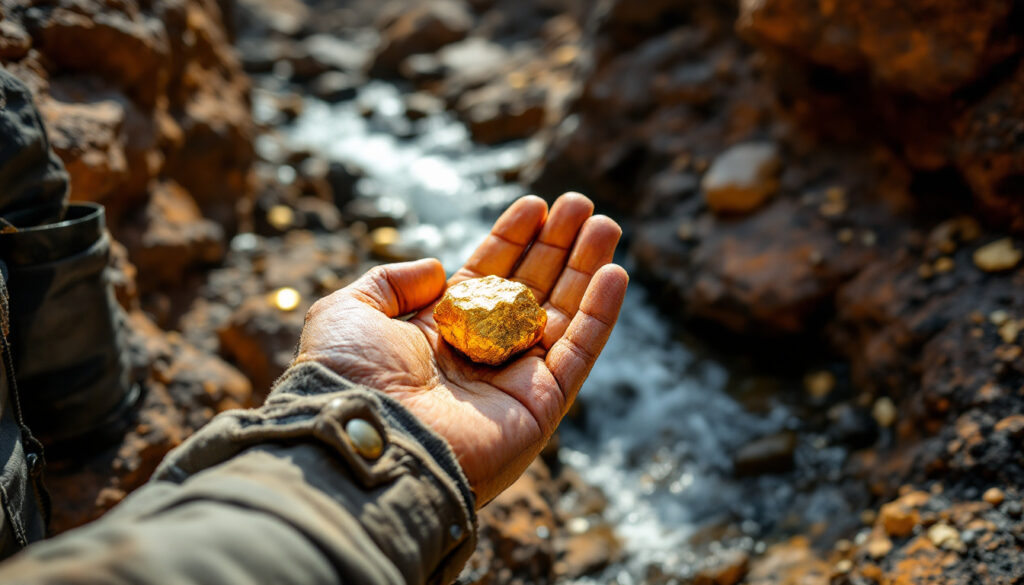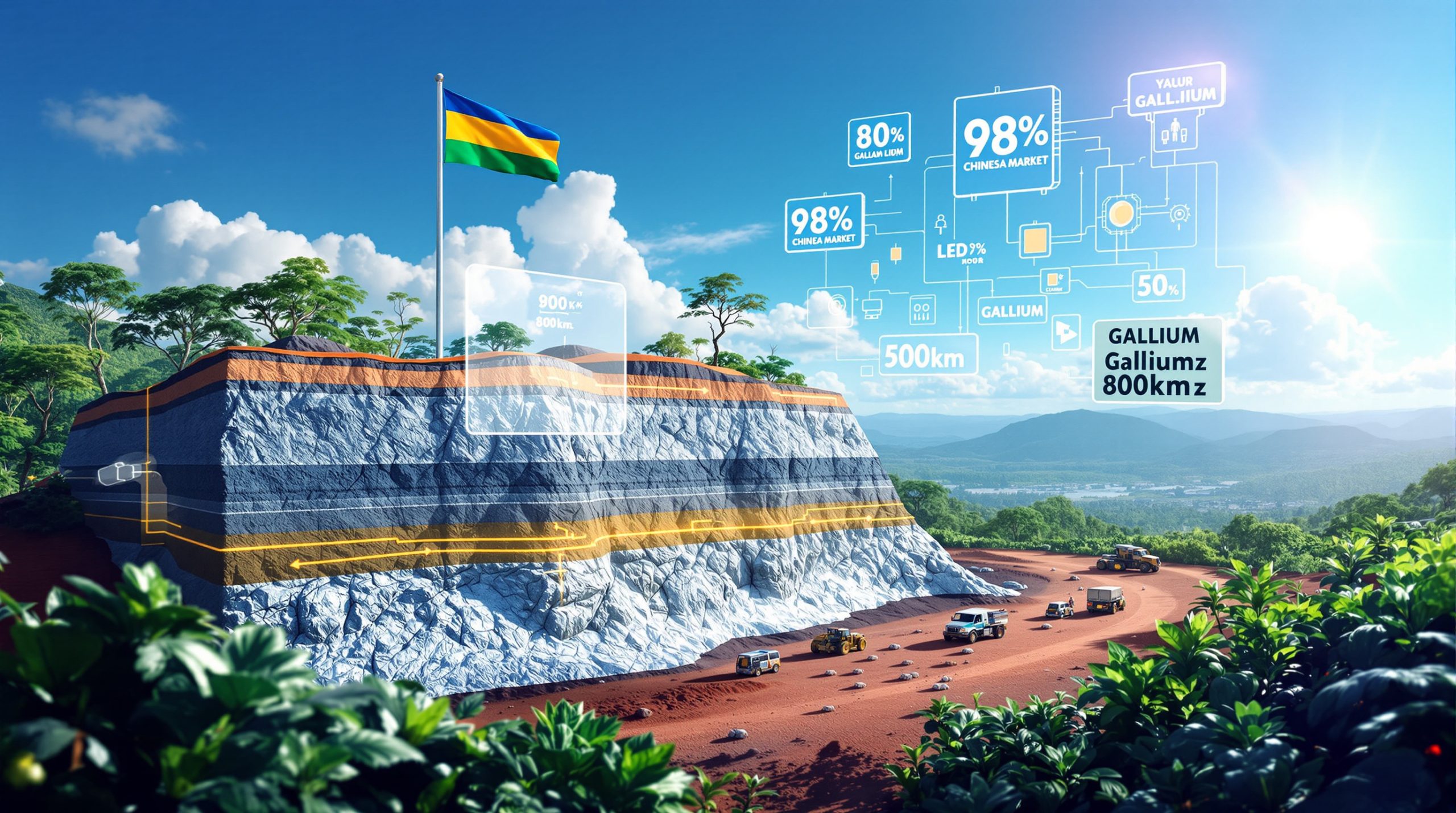What Does Gold Look Like in Nature?
Understanding Natural Gold's Appearance
Gold in nature rarely resembles the polished jewelry we're familiar with. In its natural state, gold typically appears as bright yellow metallic flakes, grains, or small nuggets embedded in host rock—most commonly quartz. Unlike many minerals that sparkle or glitter, natural gold has a distinctive buttery or soft yellow glow that appears somewhat dull under normal light.
When examining potential gold samples, remember that gold is incredibly malleable. You can actually flatten or dent it with a knife or other hard object—a key characteristic that helps distinguish it from look-alikes. Gold particles also feel surprisingly heavy due to gold's exceptional density (19.3 g/cm³), making even small pieces noticeably weighter than similarly sized rocks.
Expert Insight: "When you're in the field, the weight test is crucial. If you have two similar-sized specimens and one feels significantly heavier, it might contain gold. This high specific gravity is one of gold's most distinctive properties." — Geological Field Guide
Distinguishing Gold from Pyrite (Fool's Gold)
Many prospectors, especially beginners, mistake pyrite (iron sulfide) for gold due to their similar yellowish appearance. However, several simple tests can help you tell them apart definitively:
| Characteristic | Gold | Pyrite (Fool's Gold) |
|---|---|---|
| Colour | Rich yellow with buttery glow | Brassy yellow, sometimes with greenish tint |
| Hardness | Soft (2.5-3 on Mohs scale), can be dented | Hard (6-6.5), cannot be easily scratched |
| Streak test | Yellow streak | Dark greenish-black streak |
| Structure | Malleable, can be flattened | Brittle, breaks into sharp fragments |
| Luster | Dull, metallic | Bright, sparkly, reflective |
| Weight | Extremely dense and heavy | Lighter than gold |
| Crystal form | Rarely forms crystals, usually irregular | Often forms perfect cubes or striated faces |
Field Tip: Apply the scratch test by using a copper coin or knife blade. Gold will dent or scratch easily, while pyrite will resist scratching and may even scratch the coin instead. This simple test has saved countless prospectors from the disappointment of collecting "fool's gold."
Common Host Rocks for Gold
Gold rarely exists in pure form and is typically found embedded within specific rock types:
-
Quartz veins: Milky white or translucent quartz is the most common host rock for gold, accounting for approximately 70% of lode gold deposits worldwide. Look for quartz with iron staining or small vugs (cavities).
-
Iron-stained rocks: Rusty, reddish-brown coloration often indicates oxidized sulfide minerals that may accompany gold. This "gossans" or iron cap forms when sulfide minerals weather, potentially leaving behind concentrated gold.
-
Metamorphic rocks: Especially schists and greenstones that have been altered by heat and pressure. The metamorphic processes can concentrate gold along shear zones and fault lines.
-
Sedimentary rocks: Particularly in ancient stream beds and conglomerates. The famous Witwatersrand Basin in South Africa—source of nearly 40% of all gold ever mined—consists of ancient conglomerates.
-
Black sands: Concentrations of heavy minerals like magnetite, hematite, and ilmenite often accompany placer gold deposits and serve as important indicators when panning.
Where Is Gold Typically Found?
Geological Settings That Favour Gold Formation
Understanding the geological environments where gold forms can dramatically improve your chances of finding it. Gold concentrations typically occur in specific settings formed through various geological processes:
Hydrothermal Vein Systems (Lode Gold)
Hydrothermal veins form when mineral-rich hot fluids circulate through fractures in the Earth's crust, depositing gold along with other minerals. These primary deposits typically form at depths of 1-5 kilometers under high pressure and temperatures. Look for:
- Quartz veins cutting through metamorphic or igneous rocks
- Areas with visible iron staining or sulfide minerals (pyrite, arsenopyrite)
- Zones near fault lines or fractures that provided pathways for mineral-rich fluids
- Regions with historical mining activity
- "Stockwork" patterns of intersecting small veins
The gold in these systems is usually microscopic or visible as small flakes within quartz or sulfide minerals. Lode deposits typically contain higher-grade gold (1-10 g/tonne) than secondary deposits.
Placer Deposits (Alluvial Gold)
Placer gold forms when erosion breaks down primary gold deposits and water transports and concentrates the gold particles. Because gold is extremely dense (19.3 g/cm³), it settles in low-energy environments where water flow decreases. Prime locations include:
- Inside bends of rivers and streams where velocity decreases
- Below waterfalls and rapids where turbulence drops heavy particles
- Crevices in bedrock under streams where gold gets trapped
- Ancient stream channels and flood plains (paleochannels)
- Areas with black sand concentrations (magnetite, hematite)
- Behind large boulders in streambeds that create natural riffles
Placer gold tends to be more rounded and purer (often 90-95% pure) than lode gold because the weathering process removes other minerals.
Volcanic and Epithermal Systems
These deposits form in volcanic regions where gold is carried by hot fluids rising toward the surface, typically at temperatures between 50-300°C:
- Look for altered volcanic rocks (andesitic to rhyolitic composition)
- Areas with silicified zones and banded quartz veins
- Regions with clay-like, soft, bleached rocks (argillic alteration)
- Proximity to ancient hot springs or geothermal features
- Zones with "adularia" (potassium feldspar) and opal
Famous epithermal deposits include those found in Nevada, Indonesia, and Peru, often hosting "bonanza" grades exceeding 30 g/tonne in localized zones.
Greenstone Belts and Archean Terrains
Some of the world's richest gold deposits are found in ancient greenstone belts dating back over 2.5 billion years:
- Metamorphosed volcanic and sedimentary rocks
- Highly folded and faulted zones
- Areas with visible shear zones and deep crustal faults
- Regions with sericite and chlorite alteration
- Banded iron formations (BIFs) adjacent to granitic intrusions
The world-famous goldfields of Western Australia, Canada's Abitibi belt, and parts of South Africa's Witwatersrand are examples of greenstone belt gold deposits.
Regional Indicators of Gold Potential
When prospecting, pay attention to these landscape features:
- Contact zones where different rock types meet (especially sedimentary-intrusive contacts)
- Areas with extensive quartz veining or silicification
- Regions with historical mining activity (check local geological surveys)
- Zones of alteration (unusual coloration, soft or crumbly rocks)
- Fault lines and fractured bedrock visible in outcrops
- Ancient river channels preserved in current landscapes
- Regions with igneous intrusions cutting through older rocks
How Can You Test Rocks for Gold in the Field?
Essential Field Equipment for Gold Prospecting
A well-prepared prospector should carry these basic tools:
- Rock hammer and chisel – For breaking open rocks and extracting samples
- Hand lens (10x or 20x) – For examining small mineral grains and textures
- Streak plate – For testing the true colour of minerals in powdered form
- Magnet – For identifying magnetic minerals often associated with gold
- Gold pan – For separating gold from lighter materials through washing
- Hardness testing tools – Items of known hardness (copper penny, knife blade, glass) to test mineral resistance
- Field notebook and sample bags – For documentation and collection
- Geological compass and GPS – For recording locations and orientations
- Digital scale (optional) – For comparing weights of similarly sized samples
- Small vials – For storing potential gold samples
- Dropper bottle with dilute HCl (10%) – For acid testing (use with caution and proper safety equipment)
Simple Field Tests Anyone Can Perform
The Streak Test
This test reveals the colour of a mineral's powdered form:
- Rub the mineral against an unglazed ceramic tile or streak plate
- Observe the colour of the streak left behind
- Gold leaves a yellow-gold streak
- Pyrite leaves a greenish-black or brown streak
- Chalcopyrite produces a dark green streak
This simple test quickly eliminates many gold look-alikes, as most minerals produce streaks different from their apparent colour.
The Hardness Test
This determines a mineral's resistance to scratching:
- Try to scratch the mineral with objects of known hardness
- Gold (2.5-3 on Mohs scale) can be scratched with a copper coin
- Pyrite (6-6.5) cannot be scratched with a knife or coin
- Gold can be indented if pressed firmly with a sharp point
The Mohs scale ranges from 1 (talc) to 10 (diamond), with each mineral able to scratch those lower on the scale.
The Specific Gravity Test
Gold is exceptionally dense (19.3 g/cm³):
- Compare the weight of your sample to similarly sized rocks
- Gold-bearing specimens will feel noticeably heavier
- Even small amounts of gold can increase a rock's weight significantly
- For more precision, weigh the sample in air and then suspended in water
This property makes gold settle quickly in panning and explains why it concentrates in certain stream environments.
The Acid Test
While more advanced, this can help confirm gold:
- Apply a drop of dilute hydrochloric acid to the mineral
- Gold will not react (remains unchanged)
- Many gold look-alikes will tarnish, bubble, or change colour
- Pyrite and chalcopyrite will produce sulfurous odour with acid
Safety Warning: Always wear protective gloves and eyewear when using acids. Only use in well-ventilated areas and keep neutralizing agents (baking soda) nearby.
Advanced Field Testing Methods
Panning Technique
Panning remains one of the most effective field methods for detecting gold:
- Crush rock samples to release any contained gold
- Place material in a gold pan with water
- Agitate and wash away lighter materials with circular motions
- Gold and other heavy minerals will concentrate at the bottom
- Look for yellow flakes that settle quickly and don't float
- Use a magnet to remove magnetite from concentrates
With practice, panning can detect extremely small amounts of gold—skilled panners can recover particles as small as 0.1mm.
Using a Portable XRF Analyser
For serious prospectors with access to equipment:
- Provides real-time elemental analysis in the field
- Detects trace elements associated with gold (arsenic, silver, antimony)
- Helps identify mineralisation invisible to the naked eye
- Allows for quick decision-making about which samples to collect
- Can detect gold directly when concentrations exceed ~10 ppm
These devices cost several thousand dollars but have revolutionised field prospecting for professionals and advanced hobbyists.
What Are the Visual Clues of Gold-Bearing Systems?
Recognising Alteration Patterns
Hydrothermal fluids that deposit gold often chemically alter the surrounding rock, creating visible changes that serve as prospecting clues:
-
Iron staining: Rusty red, orange, or yellow coloration from oxidized iron minerals. These "gossans" form when sulfide minerals weather at the surface and can indicate gold-bearing systems below.
-
Silicification: Rock becomes harder, more silica-rich, and often lighter in colour. This alteration creates resistant outcrops that stand out in the landscape and frequently hosts gold mineralisation.
-
Argillic alteration: Formation of clay minerals, making rock soft and pale. This alteration type is common in epithermal gold systems and forms when feldspars break down in the presence of acidic fluids.
-
Propylitic alteration: Greenish coloration from chlorite formation. This wider alteration halo surrounds many gold deposits and indicates hydrothermal activity.
-
Sericitic alteration: Development of fine-grained white mica, giving rocks a silky luster. This alteration type is strongly associated with gold-bearing systems worldwide.
-
Decalcification: In carbonate rocks, acid dissolution creates vuggy, porous textures that may host gold. This is particularly important in Carlin-type deposits.
Structural Features Associated with Gold
Gold often concentrates along structural weaknesses in rocks:
- Fault zones and fractures where mineralised fluids can flow
- Folded rock layers that create spaces for mineral exploration importance and deposition
- Breccia zones (rocks composed of broken fragments) indicating explosive hydrothermal activity
- Stockwork veining (networks of small veins) suggesting widespread fluid movement
- Contact zones between different rock types, especially intrusive-sedimentary contacts
- "Pressure shadows" around rigid objects in shear zones
- Dilation zones where faults change direction, creating open spaces
Recognising these structures requires developing an eye for subtle features in outcrops and understanding basic structural geology.
Mineral Associations That Suggest Gold
Certain minerals frequently occur alongside gold and can serve as pathfinders:
- Pyrite (iron sulfide): The most common gold-associated mineral
- Arsenopyrite (iron arsenic sulfide): Strongly correlated with gold in many deposits
- Galena (lead sulfide): Often found with gold in polymetallic deposits
- Chalcopyrite (copper iron sulfide): Common in gold-copper porphyry systems
- Sphalerite (zinc sulfide): Found in some epithermal gold deposits
- Tourmaline (complex boron silicate): Associated with intrusion-related gold
- Quartz (silicon dioxide): The principal host mineral for gold veins
- Carbonate minerals: Common in Carlin-type gold deposits
- Adularia (potassium feldspar): Characteristic of epithermal gold systems
- Alunite: Indicates high-sulfidation epithermal environments
The presence of these minerals doesn't guarantee gold, but they significantly increase the probability and warrant closer examination.
How Do Different Gold Deposits Compare?
Types of Gold Deposits and Their Characteristics
| Deposit Type | Typical Gold Form | Associated Minerals | Host Rocks | Visual Indicators |
|---|---|---|---|---|
| Lode (Primary) | Fine grains in quartz veins | Pyrite, arsenopyrite | Metamorphic rocks, intrusions | White quartz veins, sulfides |
| Placer (Secondary) | Flakes, nuggets | Black sands, garnets | Gravels, sands | Rounded gold pieces, heavy minerals |
| Epithermal | Fine-grained, often invisible | Adularia, alunite | Volcanic rocks | Banded quartz, clay alteration |
| Carlin-type | Microscopic, invisible | Realgar, orpiment | Carbonates, siltstones | Decalcification, jasperoid |
| Greenstone-hosted | Visible in quartz veins | Tourmaline, carbonate | Mafic volcanics | Shear zones, quartz-carbonate veins |
| Porphyry-related | Microscopic, disseminated | Chalcopyrite, molybdenite | Porphyritic intrusions | Stockwork veins, potassic alteration |
| Skarn | Variable grain size | Garnets, pyroxenes | Contact metamorphic zones | Green-brown calc-silicate minerals |
| Witwatersrand-type | Fine to coarse in conglomerates | Pyrite, uraninite | Ancient conglomerates | Rounded pebbles in sandy matrix |
Comparison of Gold Grades and Concentrations
Understanding gold concentration helps set realistic expectations:
- High-grade ore: >5 grams per tonne
- Medium-grade ore: 1-5 grams per tonne
- Low-grade ore: <1 gram per tonne
- Ultra-high-grade (bonanza) zones: >30 grams per tonne (rare)
Most commercial mines operate on ore containing just a few grams of gold per tonne. For perspective, this means processing a metric ton of rock to recover the equivalent of a small paper clip's weight in gold. Visible gold in hand samples often indicates higher grades.
Gold grades vary significantly by deposit type:
- Epithermal veins: Often 1-10 g/tonne, with bonanza zones >30 g/tonne
- Carlin-type: Typically 1-5 g/t
Want to Discover the Next Major Gold Strike Before the Market?
Discovery Alert's proprietary Discovery IQ model instantly notifies subscribers when significant gold discoveries are announced on the ASX, providing actionable investment insights before the broader market reacts. Explore historic returns of major mineral discoveries and start your 30-day free trial at Discovery Alert today.




